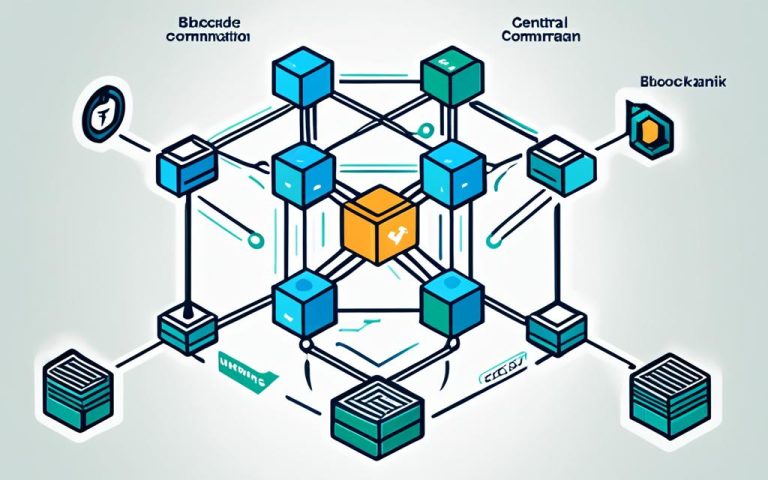Blockchain technology is often misunderstood because of many myths. It’s key to clear up these misunderstandings to really get what the technology is about. Let’s explore some common myths and uncover the truth.
Many believe blockchain is just for cryptocurrencies like Bitcoin. This isn’t true. Though Bitcoin was its first big use, blockchain’s uses go far beyond. It can be used in supply chain, healthcare, and finance to make things more open, secure, and efficient.
It’s also a myth that blockchains are too expensive and slow. Actually, they can save money by cutting out the middleman and making processes smoother. They get rid of the need for trusted third parties, speeding up and securing transactions.
Some people think blockchain is perfect and can’t be hacked. But, it’s not completely foolproof. While it’s very secure thanks to being decentralized and using complex math, hackers could still find loopholes. Yet, ongoing improvements and strict security measures are making blockchain tougher against attacks.
Breaking down these myths helps us really understand blockchain. Knowing the facts lets us discover its uses in many fields. This opens up new ways to do business and protect our digital information.
Blockchain is Not Bitcoin
Many think blockchain and Bitcoin are the same. Yet, blockchain technology stretches beyond digital money. It’s a kind of wide-ranging ledger technology, differing from other digital ledgers. Bitcoin was simply the first to use blockchain.
Blockchain is the backbone for digital currencies such as Bitcoin. It’s a system that shows transactions to everyone, making dealings clear and trustworthy. This tech could change industries by boosting security and making processes smoother.
Though Bitcoin uses blockchain, other digital coins and blockchain versions exist. For instance, Ethereum is known for smart contracts and apps without a central control.
Blockchain’s uses are vast, from tracking goods in a supply chain to securing votes and protecting intellectual property. It reaches far beyond just money matters.
To grasp how blockchain is different from Bitcoin, let’s look at their main traits:
| Blockchain | Bitcoin |
|---|---|
| Technology that enables decentralized and transparent record-keeping | First and most well-known cryptocurrency |
| Used in various industries for secure and efficient data management | Digital form of currency used for transactions |
| Supports the development of decentralized applications and smart contracts | Operates on a blockchain to facilitate transactions |
Blockchain Beyond Bitcoin
Blockchain does more than power Bitcoin. It cuts out the middlemen, saving money and making things faster. Its clear record-keeping builds trust. This makes it perfect for fields needing precise and tamper-proof records.
Platforms like Ethereum let programmers dream up brand-new apps and contracts. This shows the versatility of blockchain.
As more people use blockchain, it’s key to know it’s not just Bitcoin. While Bitcoin is a top digital currency, blockchain’s potential is much broader. It’s reshaping how we do and view transactions.
Blockchains Are Not Costly and Inefficient
Many think blockchains are expensive and not efficient. Yet, this isn’t completely true. The efficiency and cost of blockchains vary based on their design and use.
Permissioned blockchains are often more efficient and cheaper. They are made for special tasks and need permission to join. This ensures only trusted people are involved. These blockchains work faster and use less energy because there are fewer participants.
Many industries like banking and retail are adopting blockchain. They see how blockchain can make operations cheaper and more efficient. Blockchain helps them make things smoother, cut out middlemen, and avoid errors.
Public blockchains keep transactions open while keeping identities private. This keeps personal info safe from being linked to transactions. It’s especially important in sectors where keeping information private matters a lot.
Getting into blockchain doesn’t require you to be an expert. There are many tools out there to help users and companies to start using blockchain. These tools make it easy to get the benefits of blockchain without needing a lot of technical knowledge.
Blockchains are also very secure and hard to tamper with. They are built to protect information from unauthorized access or changes, making them very secure. The way blockchains are set up helps ensure that data stays safe and trustworthy.
“Permissioned blockchains are usually more cost-effective and energy-efficient compared to alternatives.”
“Blockchain technology does not require an advanced cloud-based degree to work with, with numerous tools available to assist in leveraging it.”
However, blockchain isn’t the right choice for everything. Sometimes, traditional databases might be a better fit, depending on what you need. It’s important to pick the right kind of database for each project to work best.
In short, thinking blockchains are always expensive and inefficient is wrong. Permissioned blockchains bring benefits in cost and energy. The wide adoption by companies shows its value. Blockchain is becoming easier to use with helpful tools. It’s also very secure, making data more reliable and private.
Continue reading about the various misconceptions surrounding blockchain technology in this informative infographic. You can also gain further insights into the industry by exploring this LinkedIn article and this article on Forbes.
Benefits of Permissioned Blockchains
Here is a table highlighting the benefits of permissioned blockchains:
| Benefits | Description |
|---|---|
| Cost-effectiveness | Permissioned blockchains are generally more cost-effective compared to alternatives due to reduced participant numbers. |
| Energy efficiency | With fewer participants, permissioned blockchains consume less energy compared to other blockchain types. |
| Increased privacy | Permissioned blockchains enhance privacy by decoupling identities from transactions while maintaining transparency. |
| Faster transaction speeds | By reducing the number of participants, permissioned blockchains can achieve higher transaction throughput. |
Through these benefits, permissioned blockchains offer a cost-effective and energy-efficient solution for various industries, enabling secure and streamlined processes.
Blockchain is Not Immutable and Unhackable
Many believe blockchain tech can’t be changed or hacked, but the truth is more complex. Blockchains up security but aren’t perfect. It’s crucial to know the types of blockchains and their weak points.
Public blockchains are open for anyone to join, praised for being decentralized. Yet, they face security issues and lack full privacy. Even if public blockchain transactions are set, off-chain storage can have vulnerabilities. Investopedia says these can be made safer with validation and encryption.
Private blockchains control who joins, focusing on efficiency and staying unchanged. They’re secure but not perfect and have narrow uses. According to The Motley Fool, attacking a strong private blockchain needs lots of power or tokens.
Permissioned blockchains tailor access and permissions for users. They are scalable and cost less through Blockchain-as-a-Service (BaaS). Companies like Walmart use permissioned blockchains for tasks like tracking where food comes from using Hyperledger Fabric. Synopsys points out they’re different from private ones in user access and powers.
To sum up, blockchain networks have great security but aren’t foolproof. Knowing what each blockchain type offers is key for using the technology well beyond just crypto, like in security and data handling.
FAQ
What are some common myths about blockchain?
Many misunderstandings about blockchain exist. One myth is that it’s the same as Bitcoin. Another is seeing blockchains as costly and inefficient. Some even think they are perfectly secure and unchangeable.
Is blockchain the same as Bitcoin?
No, blockchain and Bitcoin are not the same. Bitcoin uses blockchain technology but blockchain has more uses. It’s a type of tech for recording transactions, broader than just digital money.
Are blockchains costly and inefficient?
The efficiency and cost of blockchains vary. For instance, permissioned blockchains are more affordable and use less energy. They don’t all rely on heavy-duty computing like mining does.
Is blockchain immutable and unhackable?
Blockchains are tough to tamper with, but they’re not invincible. Public blockchains are more secure, yet not perfect. Private blockchains can be edited by those in charge. Also, vulnerabilities exist where off-chain data connects.



















